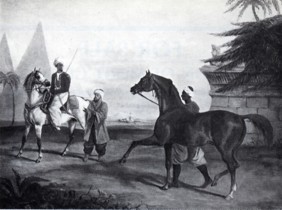|


 Heirloom is a young branch of the age-old quest for the authentic hot-blooded Arab horse. Centuries ago, our predecessors traveled to the desert sands in pursuit of the safinat, the ultimate blood horse, which could invigorate the stock of all other breeds. A hundred years ago, travelers wrote books to preserve traditional knowledge about the essential qualities comprising this remarkable equine. All the while, enthusiasts could go to the Bedouin tribes or to the caravan-destination cities at the desert's edge to procure Arab horses. After World War I, that option became rare as the socio-cultural environment of the desert horse changed forever. Heirloom is a young branch of the age-old quest for the authentic hot-blooded Arab horse. Centuries ago, our predecessors traveled to the desert sands in pursuit of the safinat, the ultimate blood horse, which could invigorate the stock of all other breeds. A hundred years ago, travelers wrote books to preserve traditional knowledge about the essential qualities comprising this remarkable equine. All the while, enthusiasts could go to the Bedouin tribes or to the caravan-destination cities at the desert's edge to procure Arab horses. After World War I, that option became rare as the socio-cultural environment of the desert horse changed forever.
One of the earliest attempts to conserve the authentic Arab horse outside its desert homeland was made by Lady Anne Blunt. In 1915, she was planning to endow a permanent stud in England composed of stock she had exported from the desert and also acquired from other early breeders in Egypt. She intended to name it The Heirloom Arabian Stud.
In the same era, Carl Raswan first went to live in Egypt and became devoted to the Bedouin horse. He traveled among the tribes for years, helped stock many foundational studs in Europe and America, and motivated owners to conserve the original characteristics of the Arab horse. It is difficult to name an early breeding program that was not influenced by Raswan. In his later years, he compiled his notes and published The Raswan Index, the "bible" of conservationists. At the same time, others began similar efforts to document various groups of the asil horses existing within the general population of registered Arabians, publishing works over the years such as The Blue Arabian Horse Catalogue, the Al Khamsa directories, the Asil Club volumes, the Pyramid handbooks, and the Sheykh Obeyd Foundation catalogues.

John W. Fippen (1922-1997) |
By 1993, many groups of asil horses had notable sponsors. However, the rare group of earliest Egyptian horses had been overlooked. Two Al Khamsa breeders, Col. John Fippen and Joan Schleicher, decided to focus upon this group. They adopted the name chosen by Lady Anne Blunt for bloodstock of this provenance and The Heirloom Arabian Stud was born. At the outset, they decided to concentrate their efforts on educating the public about the horses, not upon creating an organization. Fippen stated: "Heirloom is not an organization, not a fraternal group, not an arbitrarily selected bloodstock. Heirloom is an actual historical entity, a gene pool."
The first mission was to compile an index of all known Heirloom horses. In 1994, a list of living Heirloom horses was published together with an announcement of the Heirloom project in breed magazines. Col. Fippen then embarked on the creation of an extensive database documenting the horses aided by Debra Schrishuhn. He communicated with owners of the horses, informing them of the rarity of their animals and encouraging them to breed on within the Heirloom stock. By 1997, the Heirloom population was growing, thanks to his persistent efforts, and the Index was nearly completed. However, in December 1997, Col. Fippen died, leaving the fulfillment of his mission to his co-workers, led by his daughter Cheryl, and his wife Elizabeth.
In October 2004, Col. Fippen's goal was achieved with the publication of the 592 page reference volume, Heirloom Egyptian Arabian Horses, 1840-2000. This book places all the vital information needed for the conservation of the Heirloom bloodstock in the hands of breeders. May this knowledge empower them to propagate the Heirloom stock for many more generations.

|
|
|
